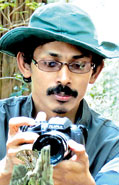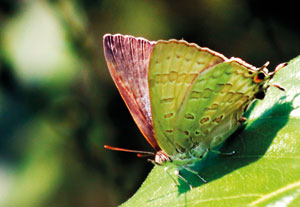Flipping through a book on those flitting beauties
View(s):By Malaka Rodrigo
Delicate and colourful, butterflies are arguably the world’s most wondrous insects. Their miraculous transformation from ordinary caterpillar to a beautiful butterfly always sparks our imagination. A comprehensive field guide on identifying butterflies has been always an essential item to promote butterfly watching. ‘An Illustrated Field Guide to the Fauna of Sri Lanka (Butterflies)’ by Rajika Gamage is definitely an attempt to fill this void.

Rajika Gamage
This is the second butterfly guidebook authored by Rajika. His first book published in 2007 was much in demand, especially as there were few butterfly books on the shelves. “I’m happy that my first guide on Butterflies turned many to butterfly watching. Many of them were action-oriented and tried to protect butterflies by planting host and nectar plants in their gardens. This has inspired me to do a second updated guide,” said Rajika.
His book illustrates all the 245 butterflies that have been recorded in Sri Lanka including 26 endemics. The illustrations show distinctive sexual and seasonal variations of the Sri Lankan butterflies where possible providing much needed guidance for novices on butterfly identification.
Descriptive text, data regarding distribution, abundance, interesting habits, habitats, and also the butterflies’ host plants have been very briefly summarised. The maps alongside each species’ illustrations show the distribution patterns, but Rajika has also presented the life cycles of 175 butterflies helping to identify eggs or caterpillars if found in the field. The ability to identify eggs, caterpillars and larval stage cocoons are special abilities a serious butterfly watcher should cultivate, he feels. “That is a challenge which is not available in other pastimes such as birdwatching,” he says.
The first section of the guide is a general introduction to butterflies and the history of their study in Sri Lanka. The second section is the main body of the guide, illustrating all the 245 species. Rajika also introduces 208 host plants that are the breeding grounds of different butterflies. “Many species of butterflies are showing a decline. By planting host plants that support butterflies in those regions, anyone can assist butterfly populations in their areas. I see this as an opportunity for butterfly lovers to contribute to their survival, so this is an important section of the book,” said Rajika.

Red spot butterfly
Although a photographer by profession who has taken thousands of photos of butterflies, he decided to sketch them to make it easier for users of his book to follow a common pattern in identifying the different species. There are over 1020 colour illustrations in the guide, but another feature of this guide book, not apparent to laymen is that all these sketches were drawn on the computer by Rajika. It is a different technique.
“It wasn’t easy initially. But I got used to it and after purchasing a special tab and an electronic pencil, I could draw the sketches more easily,” he explains. Going digital also has some advantages, said Rajika – sometimes he had only to complete one side of the butterfly and it could be replicated for the other wings.
Rajika urges all butterfly enthusiasts to go beyond simply watching them. Butterflies are good indicators of the health of the environment and the diversity of the plants in the ecosystem. They are an important element in the food chain and also efficient pollinators of many flowering plants.
“There are lots of mysteries to solve in the larval stage of many butterflies. One needs to observe them thoroughly to understand butterfly fauna,” says Rajika pointing out the interesting relationship between red ants and the caterpillar of the RedSpot butterfly.
The official photographer of the Tea Research Institute at Talawakelle, Rajika had his schooling in Baddegama, where his passion for wildlife studies was nurtured with frequent jungle trips while doing scouting.

Rajika is planning to do a series of guides on Sri Lanka’s biodiversity and this is his first. The guide was launched on March 1 at a small ceremony held at the Hector Kobbekaduwa Agrarian Auditorium. The new guide will be available on leading bookshops.
For more information, Rajika can be contacted on rajika_gamage@yahoo.com.
Follow @timesonlinelk
comments powered by Disqus



















